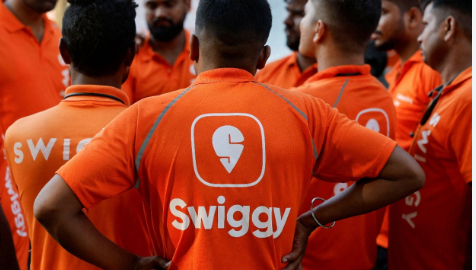
In recent quarters, Swiggy, one of India’s top food delivery and quick commerce platforms, has been struggling with widening losses. As per its financial statements, Swiggy reported a net loss of ₹1,081 crore in Q4 of FY2025 — a staggering jump compared to the ₹554 crore loss in the same period last year.
These losses, however, are not due to poor demand. Rather, they stem from heavy investments in scaling up its quick commerce arm — Instamart. As the company focuses on hypergrowth in the instant delivery space, it’s burning cash faster to build infrastructure, expand dark stores, and enhance logistics.
But despite these red numbers, Morgan Stanley, a leading global brokerage firm, believes Swiggy could soon be back in the game.
Instamart: Swiggy’s Quick Commerce Powerhouse
Swiggy’s quick commerce division, Instamart, has witnessed phenomenal growth. According to reports, Instamart’s Gross Order Value (GOV) jumped by over 101% YoY, reaching ₹4,670 crore. This explosive growth shows that consumer demand is strong, and Swiggy’s bet on quick grocery deliveries is paying off in volume.
But here’s the catch — this rapid scaling comes at a cost. Swiggy’s EBITDA loss widened to ₹840 crore, which reflects how expensive it is to build a quick delivery network across cities. Maintaining fleets, warehouse operations, and ensuring delivery within 10–15 minutes takes enormous backend investment.
Still, Morgan Stanley maintains that Swiggy has the resources, strategy, and momentum to outpace the competition in the coming years.
Market Forecast: A $57 Billion Opportunity
Why are investors like Morgan Stanley still bullish? The answer lies in the enormous potential of India’s quick commerce market. According to Morgan Stanley’s updated forecast, the quick commerce sector in India is set to grow from its current size to a whopping $57 billion by 2030 — up from earlier estimates of $42 billion.
And Swiggy is expected to capture 22% of this growing market.
At present, Blinkit (owned by Zomato) is leading with over 60% market share, but Swiggy is aggressively catching up. The gap is closing, thanks to rapid dark store expansion, deep penetration in Tier 1 and Tier 2 cities, and customer loyalty from its food delivery base.
What Is Driving Swiggy’s Comeback?
Several key factors explain why Swiggy is still seen as a serious player in the race for quick commerce dominance:
- Strong balance sheet: Swiggy is backed by deep-pocketed investors like SoftBank, Prosus, and Invesco, giving it financial strength to endure short-term losses.
- Aggressive expansion: In Q4 FY2025, Swiggy added four new dark stores every single day! This shows how serious they are about infrastructure growth.
- Brand recognition: With a massive base in food delivery, Swiggy can cross-sell Instamart easily to millions of existing users.
- Tech and logistics: Swiggy’s focus on building a robust AI-driven supply chain is helping reduce delivery times and improve order accuracy.
In short, Swiggy is playing the long-term game — sacrificing profits now to win customer loyalty and capture future demand.
The Blinkit vs. Swiggy Rivalry
Swiggy’s biggest competitor is Blinkit, owned by Zomato, which has the first-mover advantage in quick commerce. Blinkit already operates in more than 400 cities and continues to lead in dark store density and delivery speed.
However, Morgan Stanley notes that if Swiggy executes well, it could regain share and potentially overtake Blinkit in select markets. It all boils down to unit economics and execution speed.
Morgan Stanley also highlighted that both Swiggy and Blinkit are benefiting from the growing trend of consumers preferring instant grocery delivery over traditional e-commerce.
Investor Sentiment Is Improving
Following Morgan Stanley’s coverage, Swiggy’s stock performance improved noticeably. The firm gave the company an ‘Overweight’ rating, with a target price of ₹405 per share, representing a 22% potential upside.
After the announcement, Swiggy’s shares surged by 3%, signaling renewed investor confidence.
Morgan Stanley’s thesis is simple: Swiggy is investing heavily in growth, but the market opportunity is so large that the current losses are just growing pains. If Swiggy manages to sustain demand and reduce cash burn, it could become a quick commerce giant in India.
The Risks Ahead
Of course, the road ahead is not without bumps. Some major risks Swiggy faces include:
- Execution risks: Any lapse in supply chain, order fulfillment, or app performance can affect user experience and hurt brand trust.
- Intensifying competition: With new players like Zepto, BigBasket Now, and Dunzo Daily, the battle for customer attention is heating up.
- Cash burn: If Swiggy keeps spending more than expected, it may face pressure to raise new capital, leading to equity dilution.
- Regulatory hurdles: Gig worker rights, FDI policies, and taxation norms may disrupt operations or force operational changes.
But despite these headwinds, Swiggy is pressing forward with a clear strategy and bold ambition.
Swiggy’s journey in the quick commerce space is both risky and exciting. Yes, the company is bleeding money, but it’s also winning customer trust, building infrastructure, and betting big on India’s changing shopping habits.
With Instamart’s rapid growth, a strong investor base, and Morgan Stanley’s backing, Swiggy is on track to recover — and potentially dominate — in the next phase of the quick commerce evolution.In the battle for India’s 15-minute grocery economy, Swiggy is not backing down — it’s just getting started.


































